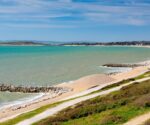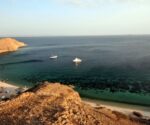Visitors flocking to ‘world’s smallest beach’ hidden away for years | Europe | Travel
Boasting just 40 metres of golden sand and crystal-clear water that’s only one metre deep, Gulpiyuri Beach in Llanes, Spain, could well be the smallest beach in the world. This peculiar beach, with no direct access to the sea, features a 40-metre coastline and shallow waters.
It was naturally formed over time due to erosion from the Cantabrian Sea on the nearby cliffs. The erosion resulted in a small natural pool, which for many years remained a secret known only to locals but has since become a unique tourist attraction. Gulpiyuri is situated about 100 metres inland from the coast, surrounded by corn-growing meadows.
At high tide, Gulpiyuri’s sand is almost entirely submerged, making it resemble a seawater pool. However, at low tide, the beach undergoes ‘drainage’, revealing the sandy surface once more.
The beach also offers numerous caves, rocks, and channels for visitors to explore, reports the Mirror.
Its semicircular shape has earned Gulpiyuri the status of a Natural Monument.
Access to Gulpiyuri is not straightforward, which has helped preserve its pristine condition over the years. However, those keen to visit this tiny wonder can reach it via a path from San Antolín beach, descending to it via a staircase carved into the cliffs.
To reach this destination, it’s advisable to park your vehicle close to the shoreline and take a brief stroll of several minutes.
Upon arriving at Gulpiyuri, visitors can witness the turbulent waters of the Cantabrian Sea on one side, whilst the opposite view reveals rolling meadows, woodland and agricultural land.
Gulpiyuri presents a perfect location for appreciating the stunning scenery and peaceful atmosphere of Asturias’ coastline.
The metre-deep waters remain remarkably still and transparent, creating an excellent environment for bathing and unwinding.
One traveller noted in a TripAdvisor review that the shoreline represents “a curiosity rather than a true bathing experience”.
A fellow visitor observed: “Really interesting geological phenomenon which means you get to sit on a beach or paddle in the sea despite that sea being separated from you on the other side of a hill at least 100m distance.”
Should the compact beach become overcrowded, there’s an alternative nearby.
Playa de San Antolín de Bedón offers a more extensive stretch of sandy and pebbly coastline, whilst also providing views towards a deserted monastery.








